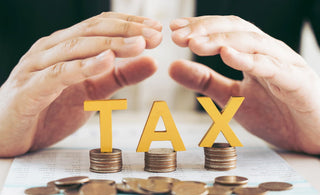
Whether you’re new to the world of investment or you’re a seasoned investor, you want to make the most out of your investment – and tax-efficient investing is the way to do so.
Whether you're planning for retirement, building a nest egg, or looking to pass on your wealth, the way you structure your investments can make a huge difference.
In this guide, we’ll cover:
- What is Tax-Efficient Investing?
- Why is Tax-Efficient Investing Important?
- Understanding Capital Gains Tax on UK Investments
- Top 5 Tax-Efficient Investments to Consider
- Is Art a Tax-Efficient Investment?
- Tax-Efficient Investing FAQs
What is Tax-Efficient Investing?
Tax-efficient investing means making strategic decisions to reduce the amount of tax you pay on your investment returns. This includes:
- Choosing tax-advantaged accounts (e.g. ISAs, pensions)
- Timing the sale of assets to maximise annual allowances
- Utilising government schemes like EIS and SEIS
- Working with financial advisers to ensure compliance and efficiency
Why is Tax-Efficient Investing Important?
Tax-efficient investing can ultimately help you make the most of your returns by minimising the impact of taxes on your gains.
When you consider taxes as part of your investment strategy, you can:
- Reduce your annual tax bill legally
- Preserve more of your returns over time
- Plan effectively for milestones like retirement, education, or inheritance
Even small changes to your investment structure can significantly improve your long-term outcomes.
Understanding Capital Gains Tax on UK Investments
When you sell an asset (like shares or artwork) for a profit, you may owe Capital Gains Tax (CGT). Here’s a quick overview:
- 2025/26 CGT allowance: £3,000
- Basic rate CGT: 18%
- Higher/additional rate CGT: 24%
Asset types like property or art are taxed at these rates (property is subject to the same rates)
You won’t pay CGT on:
- Gains under the annual allowance
- UK government bonds
- ISAs
- Your primary residence (in most cases)
You are unable to carry forward your allowance. Instead, make the most of this annual allowance every year, and consider the best time to sell your long-term investments.
Top 5 Tax-Efficient Investments to Consider
Now you have an understanding of the importance of tax-efficient investing, let’s explore some of the best options available to help you maximise your gains…
Here are five tax-efficient investment options popular in the UK:
1 - Individual Savings Accounts (ISAs)
At the top of our list, we have ISAs. These are a stable of the investment world - you can invest a maximum of £20,000 without having to pay any tax on income/ returns. There are several types of ISA to choose from, including:
- Stocks and Shares ISAs
- Cash ISAs
- Lifetime ISAs
The bottom line is that all of the interest, capital gains and dividend income from ISAs is completely tax-free. However, be wary that you can’t add more than £20,000 to your ISAs - however, you can split this allowance between different types of ISAs. This is a wise move to balance your portfolio and ultimately minimise the risk.
➤ Ideal for long-term, low-maintenance investing
2 - Pension Schemes
Pension schemes can offer tax relief at the highest rate of income tax. Pension schemes such as a Self-Invested Personal Pension (SIPP), or a workplace pension, are great choices - your pension pot will grow free of Capital Gains Tax & Income Tax.
This ultimately gives you a tax advantage in the long run, allowing you to grow your wealth without worrying about it being worn away by tax.
➤ Ideal for long-term retirement planning
3 - Premium Bonds
Next, we have premium bonds. These are issued by National Savings and Investment (NS&I). This option is a little different to other investments, as you don’t earn interest - instead, you will be entered into a monthly draw for tax-free prizes. In this draw, you can win anything from £25 to £1 million - all completely tax-free.
You can hold a maximum of £50,000 in Premium Bonds. Your return on these bonds ultimately comes down to luck. It’s important to note that the average return on premium bonds is generally lower than other investment avenues – however, the tax-free nature of this route can make it a great choice.
➤ Low-risk and appealing for tax-free gains (but average returns may be modest)
4 - Enterprise Investment Scheme (EIS)
EIS - or The Enterprise Investment Scheme - is a UK-based incentive that encourages investors to invest in small businesses. With EIS, you can make the most of benefits such as 0% CGT when you exit the investment, and 100% relief if the company you invested in goes bankrupt/ bust.
You can invest a total of £1 million per tax year, and get 30% Income Tax relief for the amount you invest in.
➤ Higher-risk, higher-reward, ideal for supporting startups
5 - Seed Enterprise Investment Scheme (SEIS)
SEIS (Seed Enterprise Investment Scheme) was launched back in 2012 as a way to encourage investors to invest in start-up businesses. It’s similar to EIS investment - however, it has slightly stricter eligibility criteria. It can be a great tax-efficient choice as you can claim up to 50% relief on investments.
This means that if you invest £10,000, you could lower your tax bill by a staggering £5,000. If the investment doesn’t go as planned, you can also claim loss relief against your income tax - making it a low-risk choice.
➤ Higher risk but excellent tax incentives
Is Art a Tax-Efficient Investment?
Art can be a valuable investment – and may offer some tax advantages:
Gains on art sales are subject to CGT (10–20%) depending on your income bracket Art qualifies as a “wasting asset” if its life is less than 50 years (some exemptions may apply) Losses from art sales may be offset against other gains
At Grove Gallery, we help clients invest in high-potential artwork. With expert curation and potential returns of up to 12% annually, art can be a rewarding – and potentially tax-smart – addition to your portfolio.
➤ Shop our original art
➤ Utilise our art advisory services
Key Takeaways
- Tax-efficient investing helps you keep more of your returns
- Use ISAs and pensions to reduce tax exposure
- EIS and SEIS offer generous reliefs for higher-risk investors
- Consider CGT rules when selling assets
- Art may be a viable part of a diversified, tax-conscious portfolio
Tax-Efficient Investing FAQs
How can I reduce my tax bill as an investor?
Use tax-wrappers like ISAs and pensions, time disposals wisely, and explore schemes like EIS or SEIS.
Are ISAs still a good option in 2025?
Yes, ISAs remain one of the best tax-efficient tools, especially for beginner investors.
Is there a limit on how much I can invest tax-efficiently?
Yes. Each scheme has a cap (e.g. £20,000 for ISAs, £1m for EIS), but smart planning helps maximise benefits.
What is the most tax-efficient way to invest for retirement?
Pension schemes (such as SIPPs and workplace pensions) are typically the most tax-efficient because of income tax relief, tax-free growth, and tax-free lump sums on withdrawal.
Do I pay Capital Gains Tax on ISA investments?
No, any gains you make through an ISA are completely free from Capital Gains Tax, making them ideal for tax efficiency.
Can I avoid tax altogether on my investments?
While it's not possible to legally avoid all tax, you can minimise your tax burden using legitimate strategies such as ISAs, pensions, and government-backed schemes.






